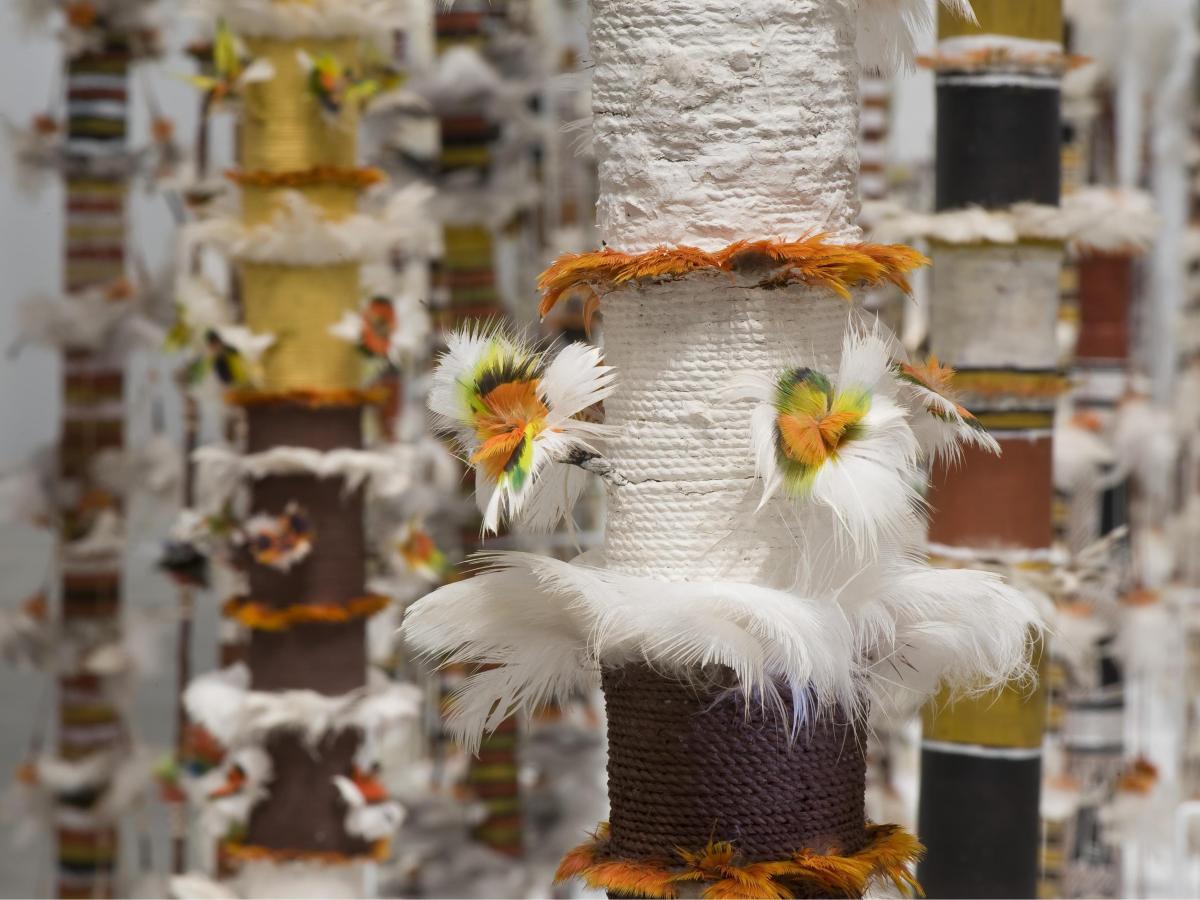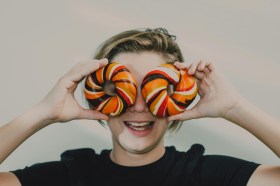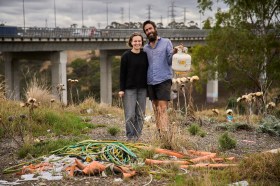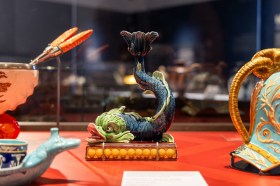Details of a group of banumbirr (morning star poles) from the exhibition ‘Floating Life, Contemporary Aboriginal Fibre Art at the Gallery of Modern Art in 2009; © The artists. Licensed by Viscopy, 2016
Lucent draws together textile-based works from the Aboriginal and Pacific Collections, illuminating the connections and differences between the cultures.
‘The continuing strength and importance of textile practice in the Pacific and Indigenous Australia continues to carry a lot of cultural weight and a place in everyday lives – it is being maintained,’ said Curator of Pacific Art, Ruth McDougall.
‘The gallery has fairly unique focus on contemporary textiles from both those places. Aboriginal Australia is very different to a lot of Island cultures in the Pacific, and you see that manifested in this collection,’ she said.
The exhibition is a very delicate and nuanced conversation in light and dark, scale and intimacy, material and gesture.
An installation of 76 feathered Banumbirr (Morning star) poles associated with creation stories dominates the space and engages with a 22-metre black Ngatu Ta Uli (barkcloth) from Tonga, used within mourning rituals.
The poles have a formal beauty and simplicity, punctuated with feathers. They were among the first objects that Westerners admired when they encountered Arnhem Land.
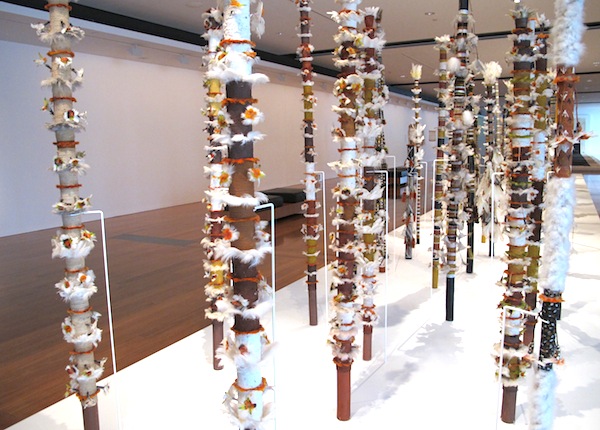
Installation view of a group of banumbirr (morning star poles) in the exhibition “Lucent” at GOMA; photo ArtsHub
The conversation continues to a suite of decorative and ceremonial pearl shell pendants, weavings and mats from both cultures.
Ruth McDougall, Curator of Pacific Art told ArtsHub: ‘There is that conversation between light and dark – obviously you have the Galiwinku (Arnhem Land) morning poles meeting the Ngatu Ta Uli, which is associated with darkness, the moon and death and is a female form, but also there is that sense of very spectacular works meeting quite intimate moments, and very delicate works associated with the body.
‘It demonstrates the importance that textile has across both realms – it can speak to important cultural concerns and have incredible cultural weight, but then it is something that is part of everybody’s daily life as well.’

Installation view / detail of Kulupu Falehanga ‘I Teleiloa / Ngatu ta’uli (2011); Koka (pigment from koka tree) and black commercial paint on Hiapo (paper mulberry) barkcloth Commissioned 2011. Queensland Art Gallery Foundation
Collection: Queensland Art Gallery
‘We both came from textile background so we have been very committed to having that kind of focus within those two collections and have certainly had the support “from above”, she said.
A position in Asia
GOMA has placed a strong emphasis on Pacific and Indigenous culture, both through its signature Asia Pacific Triennial exhibition, but also through the sustained presence, commissioning and inquiry into contemporary making now in the region.
McDougall said that it is a history that traces back to 2003 to Curator Maud Page’s Island Beats exhibition, which was the gallery’s first Pacific textiles show, and the significant show Floating Life (2010).
‘By placing this show within GOMA’s 10-year celebrations, it shows how important we see this collection as part of an ongoing conversation to who this institution is,’ said McDougall.
‘Definitely the desire to locate ourselves in Australia as part of the Asia Pacific is fundamental to my sense of where the institution sees itself going form now, where it has come from in the past ten years. It is very much a statement of who we are.’
With that institutional growth and maturity, that has also been a journey with audiences.
‘The audience has grown to know those collections, and grown to love them and that has also generated a lot of support’, she said.
Seeding new work
In the GOMA tradition, there is also recently commissioned work. A shimmering, cross-hatched piece by Yolngu artist, Gunybi Ganambarr of Yirrkala in north-east Arnhem Land, commissioned for the recent APT8, extends those traditional sacred designs on barks and larrakitj (memorial poles) to sheet metal scavenged from mining sites.
A new work by Fijian artist Maraana Vamarasi, Ibe Nauri, has been commissioned through a bequest – the Oceania Women’s Fund, which supports creative projects by women from across the Oceania.
‘It is a black Ibe Nauri – a round mat from Fiji. Traditionally they are woven out of a white kuta reed sometimes with black decoration. Black is associated with chiefs.’
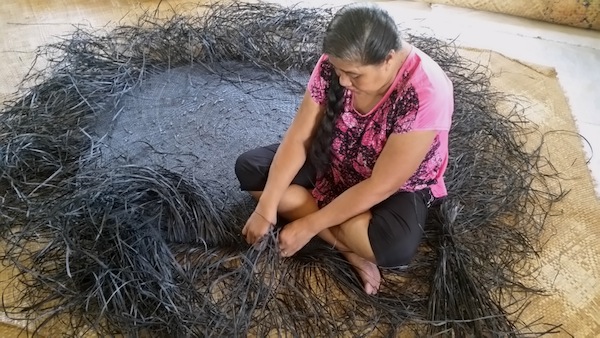
Maraana Vamarasi working on the commissioned Ibe Nauri for GOMA; image courtesy the artist
McDougall met the artist earlier this year in Guan, who was interested in attempting to weave a mat solely out of black, and the result fits beautifully within the conversations across Lucent.
She concluded: ‘Just to be inspired by and to have that sense of triggering a desire for more knowledge, more contact, more appreciation for these artists and these cultures, that is what I want people to walk away with.’
Lucent: Aboriginal and Pacific works form the Collection
26 November – 30 July 2017
